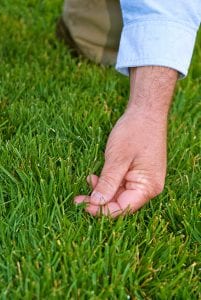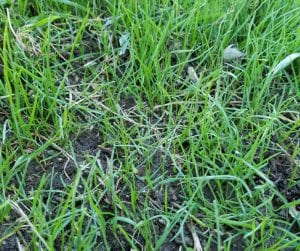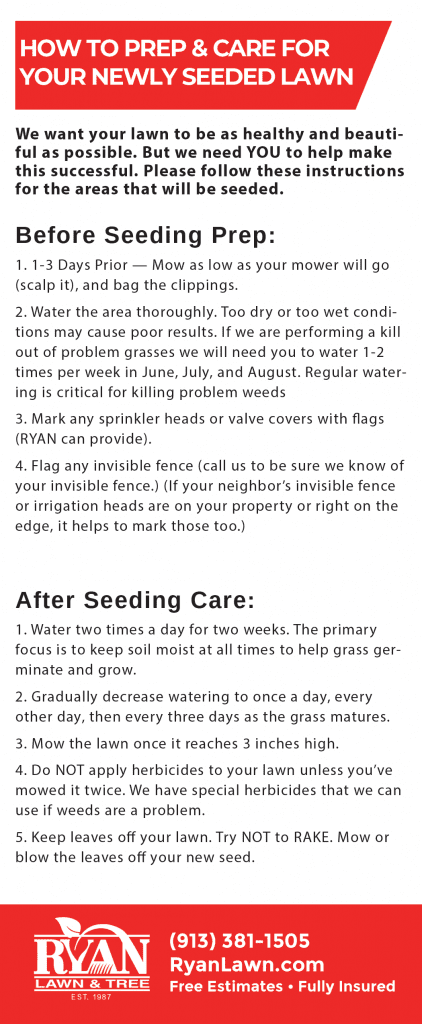The Pro Guide to Lawn Seeding
Late summer is the perfect time to start thinking about and planning for fall lawn seed.
Lawn seeding is the quintessential step to a lush, thick, vibrant yard that can capture the attention of any passerby. There are many different aspects to consider when seeding your lawn and each topic should be thought through carefully. Seeding is a big investment in the health of your lawn, so preparation is critical to giving your grass seed the highest chance of germination and providing young grass the best opportunities for maturing.

RYAN turf Pros can handle any fall seeding job, from working the soil to selecting the right lawn seed, to proper sowing.
Various facets to consider when seeding your lawn are the time of year, types of grass seed mixes, and type and pressure of weeds. Even lawn elevation and water drainage patterns can make for challenging germination. Because of the many different components to a successful seed job, it is good practice to spend some time during the summer for mapping out the prep work, understanding the process of seeding, and exploring issues to expect when germination occurs leaving your yard full of immature, fragile blades of grass.
How to Prepare Your Lawn for Seeding
Deciding whether a lawn needs grass seed is an important first step during the preparation phase. But there are many things you should consider before you move forward with your fall seeding plans. Here are six things to think about before you seed:
1. Does the lawn have high weed pressure?
High weed pressure means the lawn is weak and thin and the lawn would benefit from a solid lawn seed job. Clearing weeds is essential to a successful germination rate. It is difficult to germinate grass through dandelion and clover patches and even more difficult to provide an ideal growing environment for immature grass. It can’t be stressed enough, the first defense against weeds is a thick, healthy lawn. So control the weeds you have, and then seed your lawn to make it thick and help choke out pesky weeds that try to emerge. Our Ryan Pros can help you decide which weeds must be controlled before seeding and which ones can be controlled next year.
2. Does the lawn have undesirable turf contamination like Bermudagrass?
Warm-season grasses like Bermuda or zoysia can quickly become a nuisance as they outperform many cool-season turf types during the summer and can leave a lawn looking spotty and non-uniform during the cold months. This is an issue that can take months to rectify as herbicide treatments need to begin during the summer months to prepare a yard for fall seed.
3. Does the lawn have bare soils spots?
Obviously bare spots in the lawn are in need of seed. But you may want to evaluate why you have a bare spot in your yard. Was it from your dog, utility construction, disease, or something else? Poor soil or poor irrigation coverage can also cause the lawn to suffer and die out in areas. You may want to sample the soil or have your irrigation system evaluated. Again, our RYAN Pros can help you diagnose what might be causing the dead areas in your lawn with a soil analysis or free evaluation.
4. Is your lawn thin and weak from too much shade from your trees?
Trees and grass don’t always get along — just take a walk in the forest, you won’t see lush lawns. Those big trees in your lawn can steal sunlight AND moisture from the turf, causing the grass underneath the tree to be weak, thin, and eventually die out. Before seeding in the fall, you should evaluate trees on your lawn. Can the tree limbs be trimmed high enough to allow sunlight to reach the ground? Can you supply proper irrigation under the tree? Frequently, with large trees, the best solution is to give up growing grass and use mulch and ornamentals in larger diameter around your shade trees.
5. Does your lawn lack uniformity in color and height?
This is a personal preference. Some folks want their lawn to be all one color/shade, one height and all the blades to look the same. Other folks are perfectly fine with any grass and grass color as long as it is covering the soil. If you are in the former camp, and your lawn looks like a hodgepodge of different patches and colors, you may want to kill the entire lawn area and start over from scratch. This process requires some preparation. The yard must be killed a month or two in advance of seeding and it will require much more diligent watering during the establishment phase. But there is no better way to be the shining star-of-a-lawn in your neighborhood than to go through a total renovation. Your lawn will be the envy of all the neighbors.
6. Does the lawn have nice grass uniformity, but lack thickness?
Keep in mind some grasses can spread out to thicken up the lawn. But most cool-season lawns in our Wichita, Kansas City, Springfield, St. Louis and Tulsa areas are predominately tall fescue. Tall fescue is a clump-forming grass and it does not spread out across the lawn. So at some point over time, every Midwest yard needs to be seeded. Every year, different forces are attacking your tall fescue, killing some of it. Disease, grubs, drought, heat, flooding, traffic, dogs, sports, and many other activities are taking their toll on your lawn.
Lawn Seed Planning
Once these concerns have been diagnosed and you are committed to seeding your lawn, planning may begin for the seeding process. This generally involves the answers to three questions.

Fall seeding can result in a lush, green lawn in the spring.
1. When should I seed my lawn?
Typically, fall seeding is the most favorable time to start seed projects due to the immense advantages one can experience during this time of year. For starters, fall climates in the Midwest are typically temperate with more frequent, nourishing rains. Also, planting in the fall allows young grass to grow not only throughout the fall but also through the spring months of the following year. This means we can expect at least five months of solid growth and root maturity before the hot and dry stresses of summer. Fall seeding can start as early as mid-August, so it’s good to begin getting your seed plan in line now. If for some reason you can’t seed in the fall, Dormant seeding over the winter and spring seeding are two other options, but just know there are risks and your grass won’t be as mature going into summer stress time.
2. What is the best grass seed for my lawn?
Finally, a grass seed type needs to be decided on. For the Midwest, a cool-season grass like tall fescue is the popular choice due to its drought tolerance, cold and mild heat tolerance, and the fact that it stays vibrantly green for a large portion of the year. During hot summer months, fescue can struggle but this time frame is minuscule compared to the year in its entirety. Kentucky bluegrass is also a good choice to mix with tall fescue. A small amount of Kentucky bluegrass, less than 5% in your seed mix can be desirable. Tall fescue is a bunch type grass and Kentucky bluegrass spreads by rhizomes. And the two species are not susceptible to the same diseases. Kentucky bluegrass will struggle and go dormant quicker in the summer than tall fescue. But the two mixed together, provides good color, density, and the spreading bluegrass can fill in some lightly damaged areas.
3. How often do I water my lawn after seeding?
A step that is not often considered, or simply underestimated is judging how big an area you can realistically seed. Juvenile seedlings need copious amounts of water and for some homeowners, this can be a difficult prerequisite to meet. Obviously, for irrigation system owners this decision can be a step that is essentially skipped, but for everyone else dragging hoses and sprinklers around their yard, this can be an arduous, time-consuming task. Homeowners should be mindful and honest with themselves about how much young grass they can keep watered. Seed is expensive, therefore going through all the prep work and money just for grass to germinate and die due to lack of water would be a major disappointment and ultimately, a waste of time.
A good rule of thumb is that grass seed is going to need to be watered at least once a day, every day until it germinates, continuing every day for two weeks after germination. This is, on average, about a four-week time period. After those four weeks are up, your baby seedlings will still need to be kept moist with waterings every two to three days for about two more weeks, and then you can start shifting to watering every three to four days for about two weeks. And all of this will depend upon sunlight, temperature, wind, and rainfall.
The most common failure with new seed, is people quit watering too soon. They tend to water diligently until they see the seedlings emerge. For some reason, as soon as they see the beautiful green fuzz across their lawn, they think the job is over and they can quit watering. DO NOT STOP WATERING. Those seedlings have very short roots, less than half an inch. If the top half-inch of soil dries up, your expensive seedlings will die.
How to Seed a Lawn
Once prep work has been done, a date has been set, and the scope of the project has been realized, it is time for an effective, efficient seed job. One of the biggest misconceptions about grass seed is that it can be thrown down anywhere and left to do its thing. In my experience, this approach is a waste of time. The seed must be in contact with the soil. Whether you use a garden rake, an aerator, or a power-rake/verticutting machine, you need to work the seed into the top half-inch of soil. Seed that is left on top of the soil usually does not germinate as well, if at all. A successful seed job should only need slight touch-ups once grass matures. Therefore, you want to follow the proper procedures to ensure maximum germination rates and maximum survivability. Here is a good seeding checklist.
- Ground prep. Existing turf needs to be scalped down as low as possible and you need to rake, blow, and/or bag the debris away. Water the planned seeding areas prior to applying seed.
- Ensure seed-to-soil contact — verticut, aerate, or work the soil. Once lawn seed has been applied, some sort of mechanical action needs to take place. The seed needs to be worked into the top half-inch of the soil, so that seed is protected from washing away, and from drying out.
- Use a seed mulch or erosion control blanket if needed. You may see some folks using straw when seeding. Do not use straw. The straw will introduce weed seeds into your seedbed and it typically does more harm than good, smothering some seedlings, and moving around from wind and rain. Commercial seed aides, like paper pellets or erosion-control seeding blankets can help hold moisture and stabilize the soil during seeding.
- Fertilize. Apply a ‘starter’ fertilizer. A ‘starter’ fertilizer is a lawn fertilizer that is designed to feed and nourish germinating grass seedlings. Do not use garden fertilizers like 13-13-13 or 10-10-10. Use a lawn fertilizer that has been designed to be the correct balance of nutrients for new emerging grass seedlings.
- Water. Immediate watering is necessary. Carefully follow the watering rules above. Heavy downpours carry the risk of washing lawn seed away.
- No herbicides. Do not apply any herbicides during this critical time as grass can be damaged in this frail state. Most over-the-counter products require that you wait two mowings before you use an herbicide on young grass.
- Enjoy. Turf can be considered mature enough for normal use after three to four mows.
Mastering the Challenges of Your Newly-Seeded Lawn
A newly seeded lawn will face unique challenges compared to other, more mature lawns. Turf is fragile and can potentially take up to two years before fully mature. During this period typical lawn challenges are only exacerbated including drought, heat, insects and disease. All these issues will typically need some sort of solution at some point in time.

Newly-seeded lawns result in baby grass like this that requires careful nurturing.
Be extra vigilant on watering during the hot summer months, when temperatures are mild. Water less often to encourage root growth. Consider using turf disease control measures, young grass has not developed the same immunities as mature stands of grass have and are vulnerable to typical turf diseases like brown patch and pythium. These diseases can have devastating effects on a lawn and should be expected with newly seeded lawns.
Seeding projects can be a challenging task, often underestimated and expensive. Planning and effort are necessary for successful seed jobs and beautiful turf lawns. The end results can be attention-grabbing, as yards can take on dramatic appearance changes within a short amount of time. Taking time to consider the many facets of seeding can yield fantastic results and the best yard on the block.
Save the Stress – Contact RYAN for Lawn Seeding Today!
The bottom line is, EVERY lawn will need to be seeded at some point — maybe not every year — but every tall fescue lawn will become thinner over time and will need to be seeded to maintain thickness and health to maintain the fight against weeds. If it’s time for your lawn to be seeded and you would rather save the time and stress of planting grass seed this fall, give the Pros at Ryan Lawn & Tree a call at 855.216.2293 or get started with a FREE ESTIMATE. Our experts are happy to visit your home and give you an estimate on fall seeding using the best type of grass seed for your area and soil type. You can even sign up for our Signature Lawn Care program that will have your lawn looking lush and green all season long. Whether you want your lawn care in Tulsa, Wichita, Broken Arrow, Shawnee, Overland Park, Branson, St. Louis, Kansas City or Springfield, your neighbors trust RYAN to seed your lawn right. Call today!










